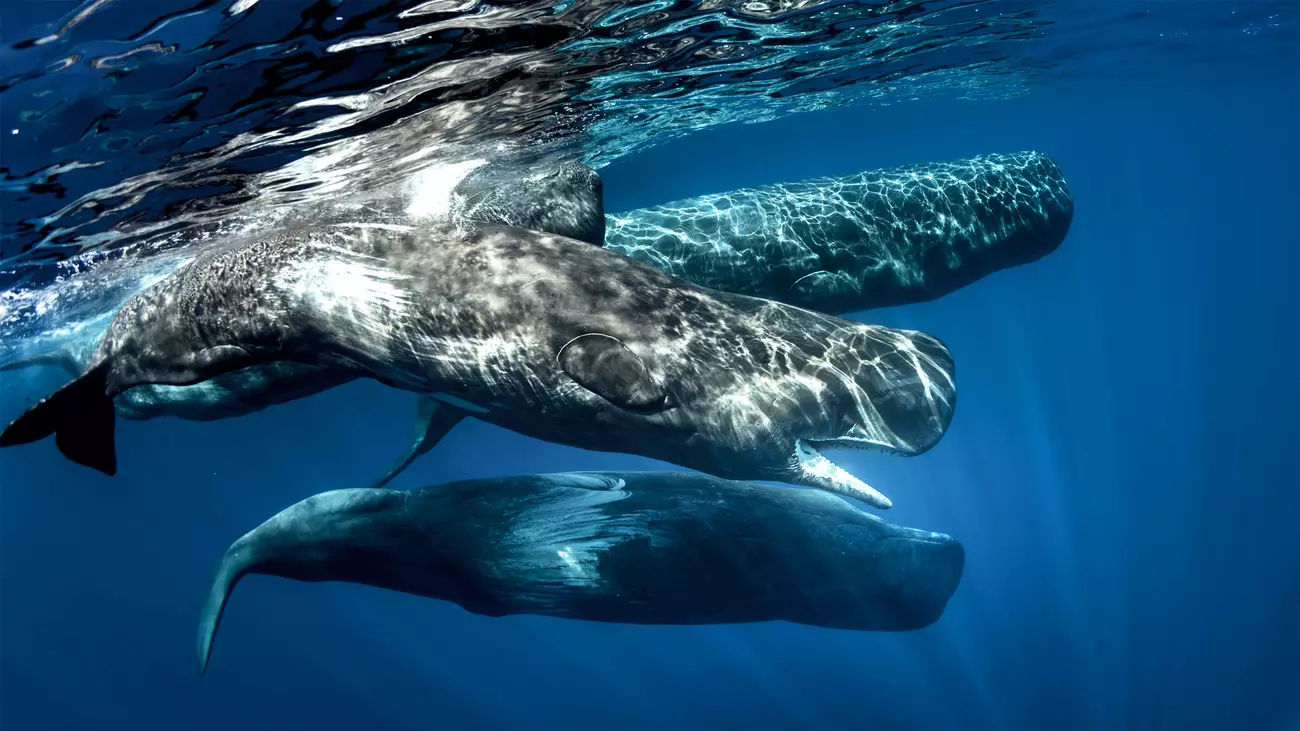1. Sperm whale

Sperm whales (Physeter macrocephalus) are regarded as the loudest animals on the planet, capable of making sounds up to 230 decibels. This is louder than the sounds of jet engines, which are about 150 decibels.
Like other whales, sperm whales communicate with one another through sound. It’s estimated that their calls can travel thousands of miles through the ocean. Sperm whales also use their clicking sounds for echolocation, to locate their prey—which include giant squid—in deep, dark waters.
Want to help protect marine mammals like sperm whales from vessel strikes and ocean noise pollution?
2. Pistol shrimp
Pistol shrimp, also known as snapping shrimp, are crustaceans in the family Alpheidae capable of producing sounds up to 189 decibels with the snap of their large claws. They are known for their asymmetry—one claw is always much larger than the other, and this is the one that can produce a sound powerful enough to stun their prey.
Pistol shrimp wait in burrows for fish to swim by, and they detect them using their antennae. After sensing the presence of fish, they make their ‘shot’, which gives them their name.
One snapping shrimp species is known as the Pink Floyd pistol shrimp (Synalpheus pinkfloydi) after the rock band—this is because their large claws are bright pink. It’s fitting considering the sound they emit can reach levels louder than a rock concert
3. Blue whale
In addition to being the largest animals in the world, blue whales (Balaenoptera musculus) are among the loudest—their vocalisations can reach 188 decibels. They use their loud voices to communicate with other blue whales across hundreds of miles. Their sounds have been described as pulses, grunts, groans, and moans.
4. North Pacific right whale
The North Pacific right whale (Eubalaena japonica) and its cousin in the North Atlantic are some of the loudest animals on Earth. Capable of producing sounds up to 182 decibels, North Pacific right whales typically only make loud, individual sounds, but in 2019, researchers discovered that they can also ‘sing’. Alongside the critically endangered North Atlantic right whale, North Pacific right whales are some of the rarest whales on Earth.
5. Atlantic spotted dolphin
The whistles of Atlantic spotted dolphins (Stenella frontalis) can measure up to 163 decibels from just one metre away. These acrobatic dolphins are also known to leap out of the water and ‘surf’ in the waves created by boats.
Atlantic spotted dolphins—like many other marine mammals—are threatened by ocean noise pollution, as it disrupts their ability to communicate. Learn more about how IFAW is working to reduce ocean noise.
6. Bottlenose dolphin

Similar to spotted dolphins, bottlenose dolphins (Tursiops truncatus) can produce whistles up to 163 decibels, measured from one metre away. These dolphins are highly intelligent, and they use various sounds for communication and high-frequency echolocation to locate prey—which includes fish, squid, and crustaceans. Communication is key, as they often hunt in groups, working together to herd fish or corner them against the edge of a sandbar.
7. North Atlantic right whale
One of the most endangered marine mammals in the world, the North Atlantic right whale is also one of the loudest—it can produce sounds measuring up to 150 decibels. On land, this sound level would be comparable to that of fireworks or gunshots. However, as they make these sounds in the ocean, they aren’t heard by the human ear in the same way. If you were swimming next to a bellowing North Atlantic right whale, it wouldn’t hurt your ears like standing next to a bursting firework would.
In addition to vessel strikes and fishing gear entanglement, right whales are severely impacted by ocean noise pollution, and with only about 350 of these whales remaining, solving this issue is critical for the species’ survival. Researchers recently found that North Atlantic right whales are shouting in response to increased noise in their habitats.